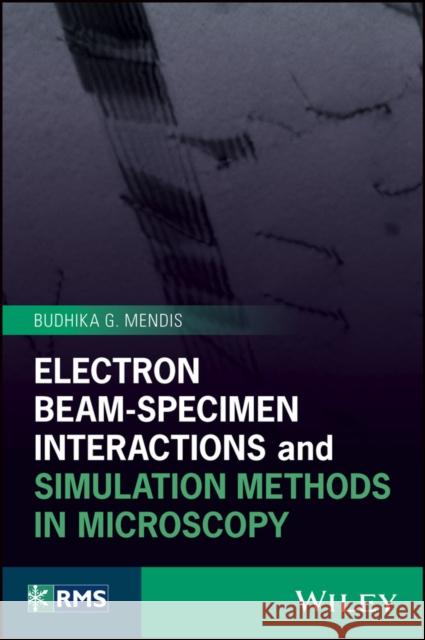Electron Beam-Specimen Interactions and Simulation Methods in Microscopy » książka



Electron Beam-Specimen Interactions and Simulation Methods in Microscopy
ISBN-13: 9781118456095 / Angielski / Twarda / 2018 / 296 str.
Electron Beam-Specimen Interactions and Simulation Methods in Microscopy
ISBN-13: 9781118456095 / Angielski / Twarda / 2018 / 296 str.
(netto: 500,34 VAT: 5%)
Najniższa cena z 30 dni: 523,19
ok. 30 dni roboczych
Bez gwarancji dostawy przed świętami
Darmowa dostawa!
A detailed presentation of the physics of electron beam-specimen interactions Electron microscopy is one of the most widely used characterisation techniques in materials science, physics, chemistry, and the life sciences.
Wydanie ilustrowane
Preface ix1 Introduction 11.1 Organisation and Scope of the Book 3References 82 The Monte Carlo Method 92.1 Physical Background and Implementation 112.1.1 Elastic Scattering By an Atomic Nucleus 112.1.2 Inelastic Scattering by Atomic Electrons 182.1.3 Implementation of the Monte Carlo Algorithm 232.2 Some Applications of the Monte Carlo Method 272.2.1 Spatial Resolution and Backscattered Imaging 272.2.2 Characteristic X-Ray Generation 342.2.3 Cathodoluminescence and Electron Beam Induced Current Microscopy 372.3 Further Topics in Monte Carlo Simulations 402.3.1 Classical or Quantum Physics? 402.3.2 Spin-Orbit Coupling and the Mott Cross-Section 432.3.3 Dielectric Model of Stopping Power and Secondary Electron Emission 462.4 Summary 49References 503 Multislice Method 533.1 Mathematical Treatment of the Multislice Method 563.1.1 Specimen Transmission Function 593.1.2 Fresnel Propagator Function 663.1.3 Objective Lens Contrast Transfer Function and Partial Coherence 713.1.4 Implementation of the Multislice Algorithm 763.2 Applications of Multislice Simulations 783.2.1 HREM Imaging and Electron Crystallography 783.2.2 CBED and STEM Applications: Frozen Phonon Model 873.3 Further Topics in Multislice Simulation 933.3.1 Accuracy of Multislice Algorithms 933.3.2 Is the Frozen Phonon Model Physically Realistic? 973.4 Summary 102References 1024 Bloch Waves 1054.1 Basic Principles 1064.1.1 Mathematical Background 1064.1.2 Application to Two-Beam Theory 1114.1.3 Phenomenological Modelling of Thermal Diffuse Scattering 1164.1.4 Bloch States in Zone-Axis Orientations 1244.2 Applications of Bloch Wave Theory 1324.2.1 HREM Imaging 1324.2.2 HAADF Imaging 1344.2.3 Bloch Wave Scattering By Elastic Strain Fields 1444.3 Further Topics in Bloch Waves 1494.3.1 Dopant Atom Imaging in STEM 1494.3.2 Electron Channelling and Its Uses 1564.4 Summary 160References 1615 Single Electron Inelastic Scattering 1655.1 Fundamentals of Inelastic Scattering 1665.1.1 Electron Excitation in a Single Atom by a Plane Wave 1665.1.2 Mixed Dynamic Form Factor 1805.1.3 Yoshioka Equations and Inelastic Scattering within a Crystal 1895.1.4 Coherence in Inelastic Scattering 1955.2 Fine Structure of The Electron Energy Loss Signal 2015.2.1 Origin of Fine Structure 2015.2.2 Core Hole Effects 2065.2.3 Magnetic Circular Dichroism 2095.3 Summary 211References 2126 Electrodynamic Theory of Inelastic Scattering 2156.1 Bulk and Surface Energy Loss 2166.1.1 Energy Loss in an 'Infinite' Solid 2166.1.2 Phonon Spectroscopy 2266.1.3 Interface and Surface Contributions 2326.2 Radiative Phenomena 2446.2.1 Cerenkov Radiation and Band Gap Measurement 2446.2.2 Transition Radiation 2496.3 Simulating Low Energy Loss EELS Spectra 2536.3.1 Discrete Dipole Approximation (DDA) 2536.3.2 Boundary Element Method (BEM) 2546.4 Summary 259References 259Appendix A The First Born Approximation and Atom Scattering Factor 263Appendix B Potential for an 'Infinite' Perfect Crystal 267Appendix C The Transition Matrix Element in the One Electron Approximation 269Appendix D Bulk Energy Loss in the Retarded Regime 271Index 275
BUDHIKA G. MENDIS, PhD, is Associate Professor at the Department of Physics, Durham University, UK, where he teaches electron microscopy at both undergraduate and postgraduate levels. He has over 15 years of experience in all the major electron microscopy techniques, including aberration–correction, and has used many of the simulation methods discussed in this book as part of his own research.
A detailed presentation of the physics of electron beam–specimen interactions
Electron microscopy is one of the most widely used characterisation techniques in materials science, physics, chemistry, and the life sciences. This book examines the interactions between the electron beam and the specimen, the fundamental starting point for all electron microscopy. Detailed explanations are provided to help reinforce understanding, and new topics at the forefront of current research are presented. It provides readers with a deeper knowledge of the subject, particularly if they intend to simulate electron beam–specimen interactions as part of their research projects. The book covers the vast majority of commonly used electron microscopy techniques. Some of the more advanced topics (annular bright field and dopant atom imaging, atomic resolution chemical analysis, band gap measurements) provide additional value, especially for readers who have access to advanced instrumentation, such as aberration–corrected and monochromated microscopes.
Electron Beam–Specimen Interactions and Simulation Methods in Microscopy offers enlightening coverage of: the Monte–Carlo Method; Multislice Simulations; Bloch Waves in Conventional and Analytical Transmission Electron Microscopy; Bloch Waves in Scanning Transmission Electron Microscopy; Low Energy Loss and Core Loss EELS. It also supplements each chapter with clear diagrams and provides appendices at the end of the book to assist with the pre–requisites.
- A detailed presentation of the physics of electron beam–specimen interactions
- Each chapter first discusses the background physics before moving onto simulation methods
- Uses computer programs to simulate electron beam–specimen interactions (presented in the form of case studies)
- Includes hot topics brought to light due to advances in instrumentation (particularly aberration–corrected and monochromated microscopes)
Electron Beam–Specimen Interactions and Simulation Methods in Microscopy benefits students undertaking higher education degrees, practicing electron microscopists who wish to learn more about their subject, and researchers who wish to obtain a deeper understanding of the subject matter for their own work.
1997-2025 DolnySlask.com Agencja Internetowa
KrainaKsiazek.PL - Księgarnia Internetowa









